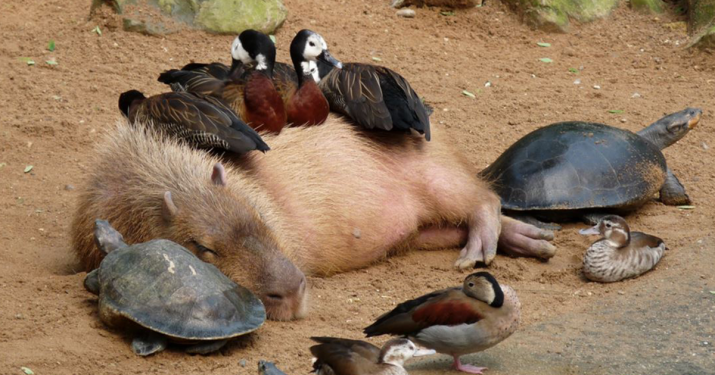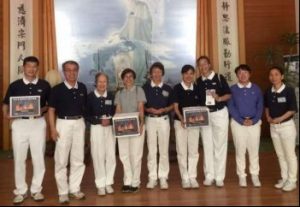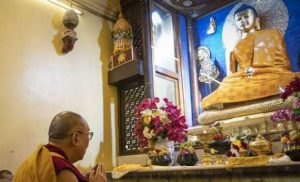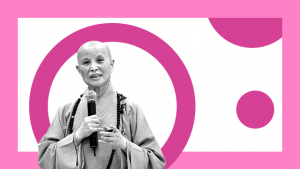
According to the Buddhist teaching, there are 10 kinds of living beings in our world, namely hell beings, hungry ghosts, animals, titans or asuras, human beings, heavenly beings or devas, arhats (sravaka), pratyekabuddhas, bodhisattvas, and buddhas.
The first three kinds (hell beings, hungry ghosts, and animals) live in the Three Wretched Realms. The first six kinds are ordinary beings that reincarnate within the Six Realms (also known as the Three Domains). The last four kinds of living beings are sacred beings that are not subject to samsara (the cycle of birth and death).
Based on the dominant and habitual mental states of sentient beings, this schema classifies them according to the results of their karma or cultivation from past lives. For instance, the primary cause of becoming of a hell being, a hungry ghost, and an animal is hatred/anger, greed, and delusion, respectively. To be born as a human being or a celestial being, one must practice the good karma of the Five Precepts, or the Five Human Virtues and the Ten Wholesome Deeds.
When it comes to the Sacred Domains, an arhat and a pratyekabuddha need to have the roots of virtue and meritorious blessings attained through the practices of the Four Noble Truths and the Twelve Links of Dependent Origination. For bodhisattvas, they must practice the Six Paramitas (in the form of a myriad of practices) over a spiritual career spanning many kalpas.
Our world is known as the Land of Saha, which is a conditioned realm subject to the endless cycle of birth and death. Saha means “endurance in sufferings.” To help as many beings as possible escape from this Saha realm, Shakyamuni Buddha urges all sentient beings to aspire to be reborn in the Land of Bliss. But this raises an interesting question: how many kinds of living beings are there in the Land of Bliss?
Referring to Amitabha’s First Vow—Non-Existence of the Three Wretched Realms—some people deduct three from the 10 kinds of living beings in the Land of Saha and think there are seven kinds of living beings in the Land of Bliss.
Four kinds of beings in the Fourfold Land
Most people examine Amitabha’s 48 vows and find that four kinds of living beings are mentioned, namely, human and heavenly beings, arhats, bodhisattvas, and Amitabha Buddha.
Following the doctrinal teaching of the Tiantai school, the patriarchs set up a model of a Fourfold Land in the Land of Bliss:
1. Land for Both Ordinary and Sacred Beings—all four kinds living together like the Land of Saha.
2. Expedient Land of Non-Ultimacy—only Sravakas or above can get access to this Land. Ordinary and heavenly beings cannot see this Land.
3. Land Adorned with Real Reward—restricted access for bodhisattvas and Amitabha Buddha only.
4. Land of Constant Light and Stillness—solely for Amitabha Buddha.
With respect to the Dharma Realms, this model is logical and commonly accepted by most Buddhists because it is based on the conventional bodhisattva teaching that emphasizes the stages of mind cultivation.
Three kinds of beings mentioned in the Amitabha Sutra
However, not all Pure Land practitioners agree with the Fourfold Land classification. As evidence, they point to three quotations from the Amitabha Sutra:
1. An immeasurable and unlimited number of sravaka disciples.
2. His assembly of Bodhisattvas is similarly vast.
3. All sentient beings born in the Land of Bliss dwell in the Stage of Non-retrogression (Bodhisattva of the 48th Stage). Many of them are in the Stage of Becoming a Buddha after One More Life (Bodhisattva of the 51st Stage).
So according to the Amitabha Sutra, there should be no human or heavenly beings in the Land of Bliss. This is further reinforced by the fact that none of the Pure Land sutras mention a “Fourfold Land” in relation to the Land of Bliss.
Moreover, since the sutra says “sravaka disciples,” it must refer to those who are disciples of a Manifestation Buddha, such as Shakyamuni Buddha in the Land of Saha, rather than of Amitabha Buddha, a Sambhogakaya Buddha. Sravaka denotes their status in the land or world before they are born in the Land of Bliss. Once born in the Land of Bliss, they become bodhisattvas in the Stage of Non-retrogression.
This interpretation also aligns with Nagarjuna Bodhisattva’s classification of the Pure Land teaching in his Chapter of the Easy Path. If all sentient beings born in the Land of Bliss dwell in the Stage of Non-retrogression, are there two kinds of bodhisattvas in the Land of Bliss, one group in the 48th Stage and the other in the 51st Stage? We will take up this question in the next article.
The Land of Bliss is the Realm of Unconditioned Nirvana—Equal in One Form
Let’s look at a paragraph in the Infinite Life Sutra. It says:
That Buddha-land, like the realm of unconditioned Nirvana, is pure and serene, resplendent and blissful. The sravakas, bodhisattvas, heavenly beings, and humans there have lofty and brilliant wisdom and are masters of the supernatural powers. They are all of one form, without any differences, but are called “heavenly beings” and “humans” simply by analogy with the states of existence in other worlds. They are of noble and majestic countenance, unequaled in all the worlds, and their appearance is superb, unmatched by any being, heavenly or human. They are all endowed with bodies of Naturalness, Emptiness, and Infinity.
This passage clearly explains that the Land of Bliss is a land where Buddhas dwell, so it is the Realm of Unconditioned Nirvana (no-birth and no-death). It is absolute because all beings dwell there on a basis of equality. They are of one form, without any separation by degrees of relativity.
The names “human and heavenly beings,” and “sravakas and bodhisattvas,” are used as figures of speech in accord with their states of existence in other worlds prior to their rebirth in the Land of Bliss.
From this, we can conclude that there is only one kind of living being in the Land of Bliss, which is so splendid in wisdom and supernatural powers that it cannot be compared with any other class of being in all of the other worlds.











